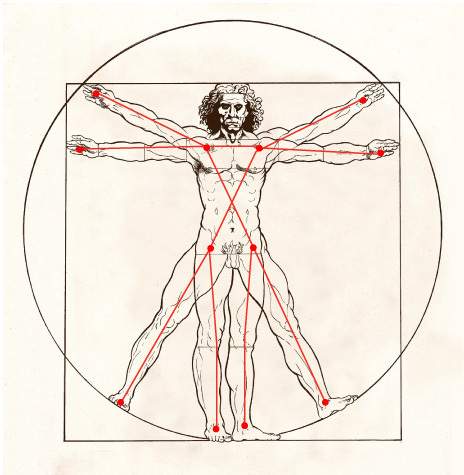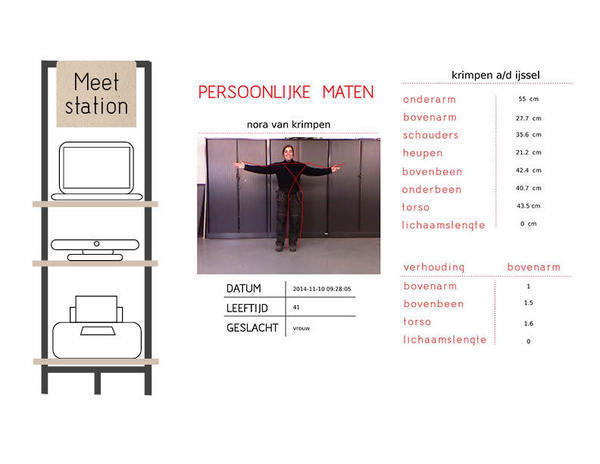Personal Measurements
Contents
The wikipage input value is empty (e.g. SomeProperty::, [[]]) and therefore it cannot be used as a name or as part of a query condition.
Author: Elise van Beurden
Inspired by the open online collection of the Rijksmuseum, being a product designer, the old measuring instruments attracted my attention. The standard metre represents the transition to the metric system as a tool. Before that, body parts were used as measurements for trading and differed per city. I was researching how personal measurements could be used again for design. The script I wrote for the Kinect has been opened up so that every installation can modify its measuring method.
The use of body measurements in design dates to a long time ago. In the 15th century, Leonardo da Vinci developed his Vitruvius based on the measurements of the human body and used it in his architecture. At Bauhaus, Le Corbusier based his design on the ideology "Mensch, Mass aller Dingen" by Ernst Neufert.
Personal Measurements is an interactive installation using the Kinect. It invites users to reveal their body measurements, thus contributing to an expanding database that calculates new average measurements per city. As soon as the Kinect tracks and measures its users, their body measurements and origins appear in the digital database. My goal is that the users' measurements can be used for a plug-in in 3d design programmes like Rhinoceros, so that users can design using their own measurements. I want this project to provoke users to have an opinion on standardisation in a time of digital revolution and ask them about their needs for the personalisation of products. The script I wrote for the Kinect has been opened up so that every installation can modify its measuring method.
Nowadays, standardisation is visible in any product. Universalisation may be convenient, but it is also limiting. More and more companies are developing 'customisation tools' to involve their users in the design process. But how open are these tools? Keeping in mind that the internet and open source are great knowledge sources for the rapidly developing 'maker movement', the role of a product designer might change from product designer to tool designer. If the consumer becomes a prosumer and contributes to the design process, the designer will be the one to design this system and its rules and limitations.
Elise van Beurden studies Product Design at the WdKA with a Minor in Open Design.Links
CONTRIBUTE
Feel free to contribute to Beyond Social.
Author: Elise van Beurden
Inspired by the open online collection of the Rijksmuseum, being a product designer, the old measuring instruments attracted my attention. The standard metre represents the transition to the metric system as a tool. Before that, body parts were used as measurements for trading and differed per city. I was researching how personal measurements could be used again for design.
The use of body measurements in design dates to a long time ago. In the 15th century, Leonardo da Vinci developed his Vitruvius based on the measurements of the human body and used it in his architecture. At Bauhaus, Le Corbusier based his design on the ideology "Mensch, Mass aller Dingen" by Ernst Neufert.
Personal Measurements is an interactive installation using the Kinect. It invites users to reveal their body measurements, thus contributing to an expanding database that calculates new average measurements per city. As soon as the Kinect tracks and measures its users, their body measurements and origins appear in the digital database. My goal is that the users' measurements can be used for a plug-in in 3d design programmes like Rhinoceros, so that users can design using their own measurements. I want this project to provoke users to have an opinion on standardisation in a time of digital revolution and ask them about their needs for the personalisation of products. The script I wrote for the Kinect has been opened up so that every installation can modify its measuring method.
Nowadays, standardisation is visible in any product. Universalisation may be convenient, but it is also limiting. More and more companies are developing 'customisation tools' to involve their users in the design process. But how open are these tools? Keeping in mind that the internet and open source are great knowledge sources for the rapidly developing 'maker movement', the role of a product designer might change from product designer to tool designer. If the consumer becomes a prosumer and contributes to the design process, the designer will be the one to design this system and its rules and limitations.
Elise van Beurden studies Product Design at the WdKA with a Minor in Open Design.










